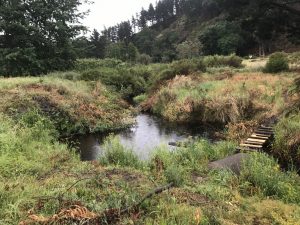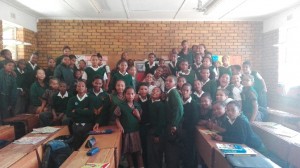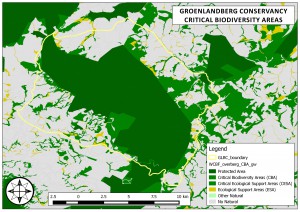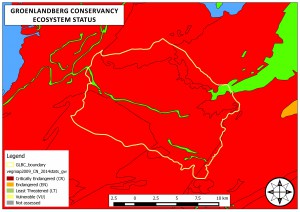Jakkals River Maintenance & Management Plan
The Groenlandberg Conservancy, established in 1994 by a handful of farmers, under the chairmanship of Dr Paul Cluver has been making an ever-increasing contribution to conservation on private and state-owned land over the past two decades. There are currently 39 active and passionate members that are committed to environmental conservation, sustainability and social uplifting.
The Conservancy has a very dedicated committee, who gets together regularly. The committee members are Stephen Rabe (chairman), Dr. Paul Cluver, Mike du Toit, Nancy Muzlai, Tony Davenport, Sebastian Beaumont, Neville van Buuren with CapeNature and DEA representatives also attending committee meetings. The Conservancy employs a part-time administrator and project manager, Anne Visser.
The Conservancy has been fortunate in partnering with key organisations like the Table Mountain Fund (TMF), who has been fundamental in making many of their conservation projects possible.
A 24-month alien clearing project along the Jakkals River was successfully completed in 2017, with generous funding received from TMF. Landowners have committed to keep the designated areas clear from all alien vegetation, after initial clearing took place, to ensure long-term conservation of the areas. Ongoing maintenance has been planned along the Jakkals River and its catchment.
The important role of the Jakkals River in the Elgin and Bot River catchment and cleansing areas has been heightened as a direct result of the integrated alien vegetation clearing program.
In 2018 the need was thus identified to develop a Maintenance and Management Plan for the Jakkals river. The Conservancy, with help from river consultants, submitted a proposal to TMF requesting funding to initiate a second phase looking at “Integrated rehabilitation of the Jakkals River ecosystem”.

The Conservancy was successful with this proposal and received further funding from TMF to engage with a river specialist and assess measures that can be implemented to rehabilitate the functionality of the river system.
The river system is currently threatened by large flood flows that results in an eroded river. Cleared lands and river banks are vulnerable to flooding and further channeling of the river. The river floods appear to be more destructive every year, resulting in major environmental, agricultural and infrastructural damage.
After extensive research, landowner engagements and site visits, a Maintenance and Management Plan was prepared by Dr. Liz Day, an independent freshwater consultant, as the mechanism for managing and achieving the project objectives. The plan has been submitted to DEADP and the Conservancy is eagerly awaiting approval.
The primary objectives of the project are to to rehabilitate forests, cleared lands and river banks with indigenous plantings, to design and agree on a River Management Plan, and to ultimately restore a healthy shape to the Jakkals River.
Creating a bee-friendly environment
The Groenlandberg Coservancy Committee set a few objectives for the Conservancy going forward at the last committee meeting. One of the main objectives of the conservancy will be to be more bee – conscious and create a bee-friendly environment.
Two presentations were held at the Conservancy meeting to discuss the current threats to our bee populations. Please follow the links below to read more.
Groenland Conservancy presentation RVeldtman
The Bee Effect_Action to effect change
Fire Awareness Education
The Groenlandberg Conservancy in collaboration with the Table Mountain Fund, World Wildlife Fund, CapeNature and Working on Fire are performing exciting Environmental Awareness Campaigns to schools and communities in Villiersdorp, Grabouw and Botriver. The aim of these clear and concise programs is to create awareness around the importance of biodiversity, wonder and value of ecosystems, habitat destruction of invasive species, illegal activities in the Groenland mountains and the crucial awareness of the dangers of uncontrolled wildfires.

Fig 1 De Rust Primary School visit.
The activities range from school visits, guided hikes, door- to- door campaigns, information stands, teacher training workshops and attending meetings regarding fire. The Facebook page “Groenlandberg Conservancy Fire- and Environmental Awareness Education” are also well underway and received 136 likes to date, where each event is posted for community members to follow our progress and success. Our results thus far to date range from interacting with 12 schools reaching 3 864 learners with our school visits and engaged with 508 community members with our door- to- door campaigns dealing with water conservation and fire awareness. We look forward for 2017 to create a conservation conscious Groenland!
More about conservancies
Click on the links below for an informative poster from Cape Nature on conservancies, what is is and why it is important.
Conservancies
Bewareas
Conservation and Environmental Awareness
Being green has become a hot topic across the world in the past few years. Overall the world has become more aware of the impact our day to day activities have on mother nature and more importantly the future of mother nature.
One of the aims of the Groenlandberg Conservancy is to conserve and protect nature through raising environmental awareness. Although everyone’s singular effort will make a difference in land conservation, it is a team effort that will turn around the damages that have already been done to the environment and that will prevent further damage. That is why it is important to always strive towards environmental awareness across the world.
Living in the digital age we can easily reach thousands of people through social media, blogs, websites and more and get the message across to protect the environment. Educators in the South Africa have the power to make a difference by teaching children about the environment and how to protect it. The Groenlandberg Conservancy raises awareness around protecting the environment through supporting the landowners in the community to better manage their land and to pass their knowledge on to their employees. The South African Government plays a vital role in environmental management and conservation in South Africa. Read more about the Government’s contributions to environmental awareness here.
Consumer Protect suggest that everyone do their part in conserving the environment by recycling, composting and by conserving energy and water. Click here for a few more tips on doing your part in saving the environment.
By educating people about conservation and environmental awareness today, we are able to ensure a better tomorrow. Join the Groenlandberg Conservancy in the Western Cape and raise awareness about protecting the environment.
Welgemoed – anyone for worm tea?
Farming principally apples and pears, Welgemoed is a large farm situated on the Vyeboom side of Van der Stel Pass. Owner Garry Southern is passionate about the landscape and the importance of keeping a piece of South African land in his family. Conservation minded, it’s refreshing to find a farmer prepared to invest in alternative and more sustainable ways of farming. His approach to nurturing and feeding his orchards is living proof of his philosophy.
Welgemoed produces and feeds their orchards 500 liters per hectare of worm tea a week. It’s a system that has been well researched and is clearly producing results. Apart from saving 30% on fertilizer costs, the worm tea also suppresses diseases and fungal infections.
Worm tea is a highly concentrated liquid, high in essential nutrients such as nitrogen, calcium, potassium and phosphate, but also containing all the healthy microbes that plants thrive on. Immediate benefits aside, by consistently applying the tea as you would any other fertilizer, you actually improve and rehabilitate the overall nature of the soil, producing a far healthier orchard in the long term.
Garry recounts the story of a diseased block, the vermitea appears to have corrected much of the problems in the roots of the Braeburns. Six years after being advised to pull out the trees in that orchard, the farm is still getting over sixty tons a hectare despite that orchard now bring in its 26th year.
The operation is set-up in a large shed, water is pumped and leached through the wormeries, carrying nutrients and all the goodness of Vermicast with it. The tea filters into a large underground tank where it is stored until it is added straight into the irrigation system once a week.
With consumers demanding a shift away from many dangerous and harmful chemicals that get used in farming, it’s uplifting to find a farm that isn’t afraid to explore alternatives.
The introduction of worm tea seems small but has far reaching effects. Welgemoed is restoring the health of their soil, ensuring strong orchards, a sustainable eco-system and a healthy crop. It impacts on overall biodiversity and that is inspiring, hopefully a trend we start seeing more of in our area soon.
Inspired to live differently at Porcupine Hills
Porcupine Hills, a farm high up van der Stel Pass and set against dramatic cliff faces, is a core member of the Conservancy. Conservation is at the heart of how the farm operates, but what is truly inspirational is how their conservation ethos has extended beyond landcare and towards becoming a fully self-sufficient entity.
Working closely with Cape Nature’s stewardship program, there is ongoing clearing and renosterveld protection taking place on the land. Cape Nature are also in the process of building walking trails that link the farm to three neighbouring properties.
A few of us were given the fantastic opportunity to escape to Klipboks, Porcupine Hills newest accommodation option. This is special place because it’s completely off the grid, and has been creatively put together using recycled building materials that were all already on the farm.
Owner Tony Davenport’s engineering passion proves that you can live off-the-grid and be very comfortable. Clever LED lighting that only run of 1 Watt of Solar Power, nifty wood burners, plans for wood fired geysers and hot tubs are all part of the mix. Cha Davenport’s artistic flair is evident in her gorgeous textile print choices and art work.
The set-up is novel and cleverly thought-out, four twin rooms, each with their own shower and bathroom, set around a large open outside entertainment area and smaller inside kitchen and living area.
Set far into the hills, we had no phone reception, and that in itself was one of the most relaxing aspects. We were told to explore, so off we trekked into the mountains. We spent hours in the surrounding hills spotting the resident black eagles, experiencing incredible rolling vista’s, and feeling the freedom that the Overberg instills.
What a refreshing escape, we can’t wait to go back!
www.pocupinehills.co.za
Launch of the Man and the Biosphere: Kogelberg Biosphere Reserve Coin Series.
This week was a very special one for our area, on the eve of heritage day SA Mint in collaboration with the Kogelberg Biosphere launched a series of commemorative coins celebrating a journey through one of the most beautiful areas in South Africa, our very own Kogelberg.
The launch ceremony took place at the Waterkloof Estate, with magnificent views across the reserve. As part of the many invited to represent the area, I felt tremendously proud of this incredible part of the world we get to call home. The collection included four gold and silver coins beautifully illustrated with well-researched scenes from the reserve.
My favorite was of course the Silver R2 coin depicting the Elgin Valley, featuring the honey bee and orchard fruit (above right).
“Queen Kogel” Joanne Strauss beautifully adorned in Okasie outfit and headdress was a charming hostess. We learnt a great deal about the UNESCO Man and the Biosphere Program passionately and cleverly explained by Johan West (chairman of the KBR) and Dr Ruida Pool-Stanvliet.
Lunch served a creative array of local produce paired with Waterkloof Wines.
All in all, a truly uplifting and inspired occasion, a showcase of our rich fauna and flora and a fantastic advert for our area. The coins will no doubt continue to carry the message and attract an even greater interest in this magnificent part of the world.
The Jakkals river ecosystem restoration project
The Groenlandberg Conservancy’s objectives include promoting the protection and conservation of indigenous plants and animals, preserving important biological communities and promoting the conservation of natural vegetation. Invasive alien plants are a major threat to biodiversity in catchment areas, potentially disrupting the delicate natural balance in ecosystems. Without natural enemies, these plants reproduce and spread rapidly, taking valuable water and space from our indigenous plants.
Nine months ago the Conservancy initiated the Jakkals river ecosystem restoration project. The project team includes Rory Allardice (Project Manager), Martiens Scheepers (Independent Contractor), Wine2Whales (project management sponsor), Cape Pine, Cape Nature, and nine landowners.
The project is going well. Funding is our constraint so we are working slowly but surely. The TMF funding is clearing strategic pockets. We are working to a programme fully integrated with CapeNature and Cape Pine. The Landowners are currently formulating their vegetation plans within the catchment. W2W are generously sponsoring the project management and assisting with trail clearing. This project would not be possible without W2W, thank you.
Now that we have plenty of felled alien plants, we are investigating an opportunity to be involved in a pilot to utilise the biomass. We will keep you updated on this exciting prospect as it develops.
Conserving our Global Biodiversity Hotspot
We were honored to have Cape Nature’s Keir Lynch address Conservancy members and visitors at Fruitways on 14 May. We had a full house of dedicated conservationists who braved the cold and dark (we had load-shedding at the time) to hear Keir address something close to his heart – the fundamental role conservancies play in conserving our area.
Keir displayed his deep knowledge of endemic and endangered species to highlight how precious and threatened our biodiversity is. Through an impressive selection of maps, he highlighted the key role conservancies (the Groenlandberg Conservancy in particular) plays. Here are a couple of his maps that show how important the natural resources of the Groenlandberg Conservancy are.


The second map shows the Conservancy’s Ecosystem Status as being Critically Endangered.
Keir’s passion and knowledge certainly brought home the importance of the work the Conservancy is doing. He highlighted how important our contributions are and how our participation and belonging is the only thing that can save our natural and threatened ecosystems through preserving this Biodiversity Hotspot



